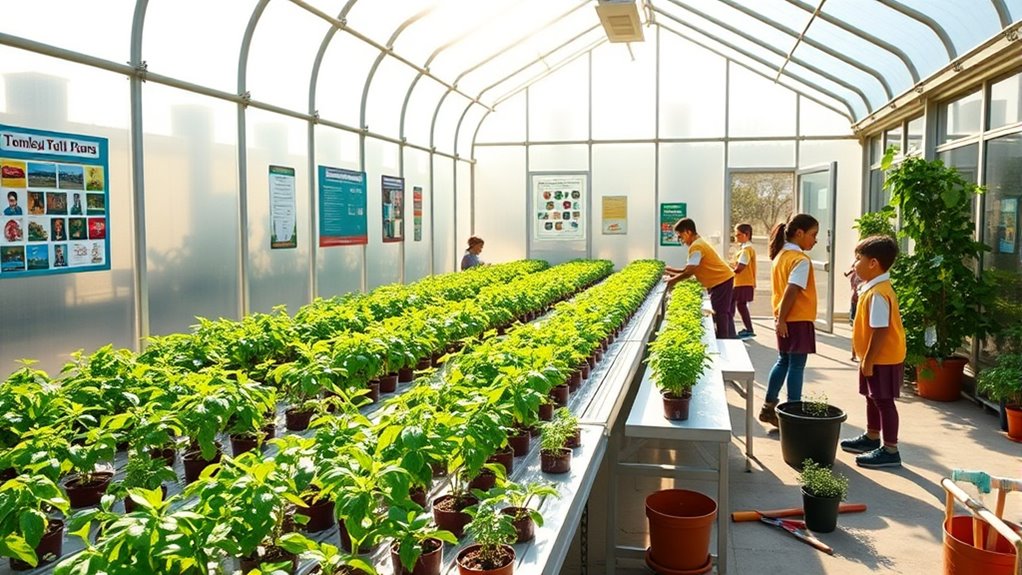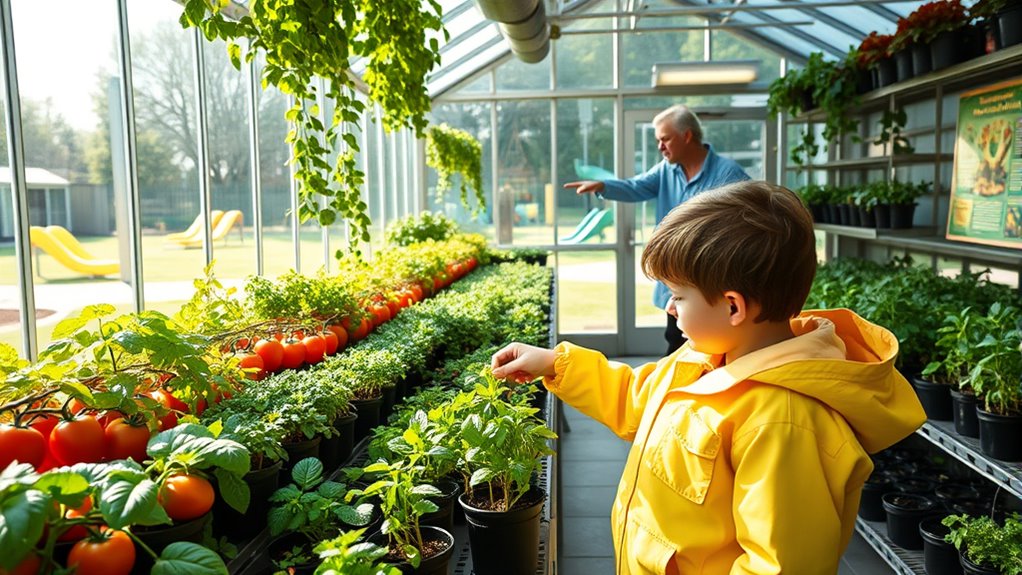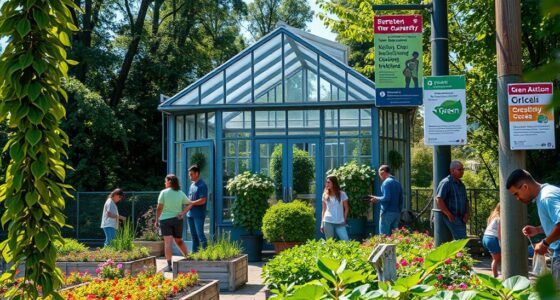To start a school greenhouse project, involve students early to foster ownership and gather ideas. Plan sustainable features like natural ventilation, rainwater harvesting, and solar shading to reduce energy use. Choose materials with high visual quality to enhance learning experiences. Incorporate hands-on activities for plant care, construction, and data collection to boost engagement. By integrating eco-friendly design with curriculum themes, you’ll create an inspiring space. Keep exploring to discover how to turn your greenhouse idea into a thriving educational environment.
Key Takeaways
- Plan sustainable greenhouse designs incorporating natural ventilation, rainwater harvesting, and eco-friendly materials to maximize environmental benefits.
- Engage students early through inclusive planning, assigning roles, and hands-on activities to foster ownership and active participation.
- Integrate the greenhouse into curricula with science, math, and ecology lessons, emphasizing real-world applications and data analysis.
- Select high-quality, vibrant materials to improve visual clarity, support multimedia use, and create an engaging learning environment.
- Develop a comprehensive project plan covering budgeting, permits, construction, maintenance, and ongoing student involvement for long-term success.

Starting a school greenhouse project is an excellent way to engage students in hands-on learning about science, sustainability, and agriculture. When planning your greenhouse, focus on sustainable design principles to create an eco-friendly environment that minimizes energy consumption and reduces ecological impact. Incorporate natural ventilation, solar shading, and rainwater harvesting systems to make the greenhouse more sustainable and cost-effective. These features not only promote environmental responsibility but also serve as real-world examples for students to observe and learn from. By integrating sustainable design, you’re teaching students the importance of conserving resources and thinking critically about their ecological footprint, which deepens their understanding of sustainability concepts. Additionally, selecting materials with high color accuracy can improve the overall learning environment by ensuring clear and vibrant visuals during outdoor lessons or integrated multimedia presentations.
Student engagement is a critical component of a successful greenhouse project. To foster active participation, involve students early in the planning process, allowing them to contribute ideas and understand the purpose behind each decision. Assign roles such as plant care coordinators, construction helpers, or data recorders, so students feel ownership over the project. Hands-on activities like building the greenhouse structure, preparing soil, planting seeds, and maintaining the plants keep students actively involved and make learning more memorable. Regularly scheduled garden days or science integration lessons can also boost engagement, ensuring students see the tangible results of their efforts. When students participate directly in the greenhouse’s development and daily operations, they develop a stronger connection to the project and a greater sense of responsibility.
In addition to design and engagement, consider how the greenhouse can be integrated into your curriculum. Use it as a living laboratory for lessons in biology, ecology, nutrition, and even math. For example, students can track plant growth, calculate yields, or analyze environmental conditions, applying academic skills in real-world contexts. This interdisciplinary approach enhances student involvement and reinforces the relevance of their education. Moreover, incorporating sustainable practices like composting and organic pest management teaches students about responsible agriculture and environmental stewardship. These lessons, combined with active participation, cultivate a sense of environmental responsibility and inspire students to pursue sustainable solutions beyond the school grounds.
Frequently Asked Questions
What Are the Best Plants for Beginner School Greenhouses?
For your beginner school greenhouse, start with easy-care plants like succulent plants and herbs. Succulents thrive with minimal watering and love bright light, making them perfect for students new to gardening. Easy care herbs such as basil, mint, and parsley are also great choices; they grow quickly and teach kids about plant growth and culinary uses. These plants build confidence and foster a love for gardening in students.
How Much Does a Typical School Greenhouse Cost to Build?
Imagine planting a seed that grows into knowledge—your greenhouse’s cost is the foundation for this future. You should plan your budget carefully, considering materials, size, and features, as these influence the cost estimation. On average, building a school greenhouse costs between $3,000 and $10,000. With smart budget planning, you’ll nurture this project into a thriving educational space, fostering growth for both students and plants.
What Safety Measures Are Necessary for Students Working in the Greenhouse?
You need to prioritize hazard prevention by ensuring students understand potential risks like sharp tools or hot surfaces. Implement thorough safety training to teach proper handling of equipment and emergency procedures. Always supervise activities, provide safety gear such as gloves and goggles, and keep walkways clear. Regularly inspect the greenhouse for hazards, and encourage students to report concerns promptly. These measures help create a safe, productive environment for everyone involved.
How Can We Integrate Greenhouse Activities Into the Curriculum?
Think of your greenhouse as a classroom where plants become your students. To boost student engagement and achieve curriculum integration, you can design hands-on activities aligned with science, math, and environmental studies. Incorporate project-based learning, such as growing experiments or sustainability projects, to make lessons more interactive. By weaving greenhouse work into your lessons, you create a vibrant, living curriculum that sparks curiosity and enhances understanding across subjects.
What Grants or Funding Options Are Available for School Greenhouses?
You’re exploring funding opportunities for your school greenhouse project. You can find grants from local government agencies, educational foundations, and agriculture programs. To improve your chances, focus on detailed grant application tips, like clearly explaining your project’s educational benefits and budget. Be sure to gather supporting documents and tailor each application to match the funder’s priorities. Staying organized and persistent will help you secure the necessary funding for your greenhouse.
Conclusion
Starting a school greenhouse project is a rewarding way to teach students about sustainability and biology. Did you know that school gardens boost student learning and engagement by up to 45%? With careful planning and passion, you can create a thriving green space that inspires curiosity and growth. Remember, every small step counts—your efforts can cultivate not just plants, but a lifelong love of learning. Get started today and watch your greenhouse flourish!









